Losses come in many different forms, but they are a constant for all businesses. Whether internal or external, intentional or unintentional, companies struggle to reduce loss. Exception-based reporting is one tool to help businesses quickly find and eliminate sources of loss.
Loss prevention is evolving along with the tactics needed to identify losses. The increase in data collection over the last two decades has placed exception-based reporting at the forefront of these changing strategies.
If you haven’t heard the term exception-based reporting (or EBR, exception reporting, among others) in a loss prevention meeting yet, then you’ll probably be hearing about it soon (or should take the opportunity to bring it up yourself)
In this article, we will explain exception-based reporting and why it is useful. We’ll also provide specific use cases for retailers and restaurants. Finally, we’ll show you how Solink works with existing business security cameras to give you the most informative exception-based reporting available today.
What is exception-based reporting?
Exception-based reporting is exactly what it sounds like. You take a stream of data and then report all the items that don’t fit the pattern.

Of course, the amount of data recorded by a modern business makes this impossible to do by hand. That’s why there are tools for exception-based reporting.
Here’s an example of an over-simplified EBR using Microsoft Excel or Google Sheets. You can set up something called “conditional formatting.” This system will change the cell or text color of an item based on its value. This draws your attention to the “exceptions” without needing to read the entire spreadsheet.
This is a rudimentary example, but let’s take a look at two systems you likely have in place that should help with more sophisticated event-based reporting: your POS and your security cameras.
After that, we’ll combine them into a real world example of how exception-based reporting will improve your bottom line.
Exception-based reporting POS
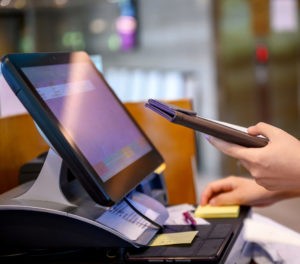 If you sell something in person, you probably use point of sale (POS) systems. Any modern POS system will collect data on the type of transaction, the transaction amounts, the number of items per transaction, the number of transactions, and the salesperson punching in the transaction.
If you sell something in person, you probably use point of sale (POS) systems. Any modern POS system will collect data on the type of transaction, the transaction amounts, the number of items per transaction, the number of transactions, and the salesperson punching in the transaction.
All of this is actionable information if you know how to use it correctly. Have you had to deal with discount abuse? Most POS exception systems can show you a list of employees by the percentage of their transactions that used a coupon code. The same can be done for voids or zero-dollar transactions.
Exception-based reporting video
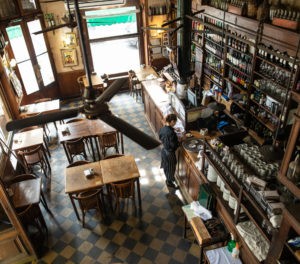 The POS shows you if an employee has been giving a high number of discounts. However, it can’t tell you if that’s discount abuse. Discount abuse is just one of the types of employee theft you should be looking for.
The POS shows you if an employee has been giving a high number of discounts. However, it can’t tell you if that’s discount abuse. Discount abuse is just one of the types of employee theft you should be looking for.
To understand what is occurring, you can leverage video verification with exception events. This saves your team hours of video and/or data research. Solink not only can find these exceptions with our event-based reporting function, but it also matches video to each event so you can confirm what’s happening during the transaction.
Exception-based reporting example
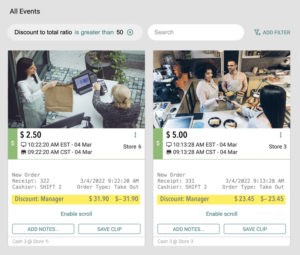 You suspect an employee is providing discounts to friends and family. Then, you search in your Solink app on your smartphone for all discount events involving the employee. Solink shows you the video clips involving discounts for that employee.
You suspect an employee is providing discounts to friends and family. Then, you search in your Solink app on your smartphone for all discount events involving the employee. Solink shows you the video clips involving discounts for that employee.
This can provide clear evidence that the employee is committing discount abuse. You can then send this video and transaction evidence to the store manager with a single click.
What’s the main difference between your current EBR system and Solink?
What’s the main difference between your current EBR system and Solink? Traditional EBR, while providing outliers, still leaves the end-user to data mine for information. This process is time intensive. Solink provides you actionable data linked to video and AI. The key difference is we bring the exceptions to the surface rather than relying on your team to mine the data.
Exception-based reporting is far more than POS or video data mining. Solink has the ability to incorporate your alarm data, chargebacks, inventory management system, and many other data sources into one platform.
Introducing Threshold Notifications
Thresholding is a way of analyzing data. You create limits on a metric and then judge the execution of your business based on whether it exceeds that limit.
Here’s an example. You want your speed of service at the drive-thru to be a maximum of 60 seconds. You can use Threshold Notifications in the Solink platform to be notified by email or SMS whenever your drive-thru speed of service goes above 60 seconds. That way you can see what happened and make any necessary changes before things get out of hand.
This is a new way of doing exception based reporting.
What you need in an exception-based reporting system
The example above illustrates why you should be performing exception-based reporting, and that not all EBR systems are the same. Here is what you should expect from a robust exception-based reporting system:
- Integrates with cameras and POS
- Allows searching all available data sources
- Automated reports for different events and exceptions
- Clear return on investment (ROI) from reduced expenses
- Uses your existing equipment—no upfront cost for new hardware
- Proactive alerts when your key metrics are outside of your comfort zone
- Save time and money pulling numbers and finding exceptions manually
- Customizable dashboard that gives the key performance indicators (KPIs) of your business

Two exception-based reporting use cases
Exception-based reporting can be used in many companies across all industries. Let’s look at two specific cases: retail exception-based reporting and restaurant exception-based reporting.
Exception-based reporting in retail
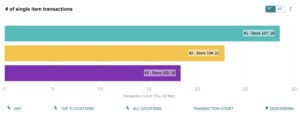 You’ve identified the number of items per transaction as a key driver of existing store revenue growth. Specifically, you want to define the percentage of single-item transactions as a KPI for sales staff to minimize.
You’ve identified the number of items per transaction as a key driver of existing store revenue growth. Specifically, you want to define the percentage of single-item transactions as a KPI for sales staff to minimize.
You set up an alert to show you any time a salesperson processes a single-item transaction. When notified, Solink shows you a video of what’s happening in your stores surrounding the transaction. You can then see how your salespeople are servicing patrons to help coach them on their upselling and cross-selling skills.
Exception-based reporting in restaurants
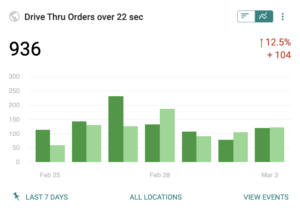 You run a QSR. Approximately 60% of your income comes from the drive-thru. Your target is to get customers from the order window to a completed transaction within 22 seconds.
You run a QSR. Approximately 60% of your income comes from the drive-thru. Your target is to get customers from the order window to a completed transaction within 22 seconds.
You set up a report alarm in your POS to be notified when a transaction requires more than 22 seconds. Every time this occurs, Solink sends an alert to your mobile device so you are notified in real time wherever you are to the slow drive-thru.
Now, you can use this EBR alarm to see why the drive-thru is moving slowly. It could be that the order size was larger than usual and the slower transaction is a blip. However, you might find that there is a training gap, and the person running the drive-thru window needs to be retrained on how to operate some key pieces of equipment.
Find what you’re looking for in seconds
Save hours sifting through video and uncover suspicious cash handling in our self-guided tour.
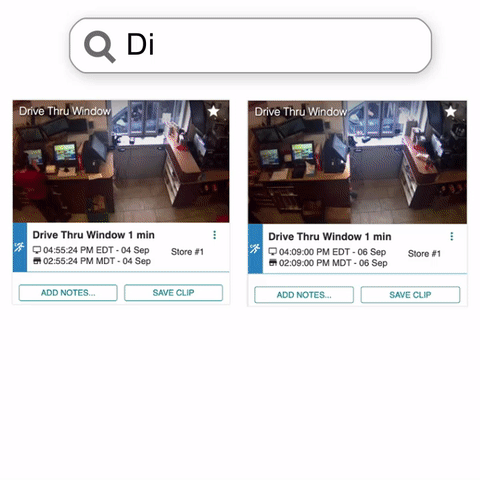
Five tips to help your company perform exception-based reporting
Exception reporting is all about getting a good process in place, and then executing it on a regular basis. Here are some tips on how to build a robust EBR process.
1. Get stakeholders onboard
Getting the loss prevention team on board for EBR should be pretty easy. Solink will save them time and money while increasing their performance. However, if you are only using exception-based reporting for loss prevention, then you are losing a lot of the value hidden in video and POS data.
Exception reporting can help every team in your organization. Regular EBR auditing can help you find opportunities to improve employee training, track inventory, and even reduce risks.
2. Add EBR to your loss prevention processes
Exception-based reporting needs to be part of your workflow. With limited time and resources, your team needs a system that feeds them outliers. This is a fundamental change from traditional EBR systems that require the end-user to sift through data.
Losses are constantly occurring in your business. With every new product introduced, POS and Inventory control programs become ever more taxed in controlling and identifying how losses occur. Running an EBR audit might help you find the avenues of loss today, but it won’t help you catch (or better prevent) the losses of tomorrow.
Using Solink, which makes tracking down fraud fast and easy, means you can run exception-based reporting every day. Our exception-based reporting loss prevention software helps you gain an edge on all the sources of loss in your business.

3. Change your loss prevention culture
Loss prevention can no longer be reactive. Long established norms of locking down departments can hinder sales. Understanding your data and how to use physical deterrence devices (e.g., alarm triggers on highly targeted inventory) will have a positive impact on your ROI.
What does it mean to be proactive? It requires a potential shift in priorities, pivoting to the threats identified in your data. Your data needs to adapt to your business needs for you to be competitive. Your sales culture is constantly shifting. Today’s loss prevention departments need a tool that allows them the same flexibility.
These are big changes, requiring a tool that gives you the flexibility to compete with your sales culture. Once you see the ROI, every other department will be looking for ways to capitalize on these changes.
4. Provide users with targeted coaching
 Powerful platforms like Solink have many features. You might only have one or two in mind when first evaluating the solution. However, to get the biggest ROI, you need to use all of the functions that have value to your enterprise.
Powerful platforms like Solink have many features. You might only have one or two in mind when first evaluating the solution. However, to get the biggest ROI, you need to use all of the functions that have value to your enterprise.
Solink offers unlimited free coaching to your staff so everyone knows what’s available and how to use it, ensuring they get the most from all the features in the platform.
5. Compare your current system to modern alternatives
Not all video analytics platforms need you to run new, expensive, proprietary hardware.
Solink, for example, can work with the cameras you have onsite and integrate with your existing POS. In addition, the old fisheye distortions of 360° cameras are gone with Solink’s algorithms, which use gaming technology to improve the way video renders in the platform.
That being said, newer cameras do have remarkable quality and fields of view. If you are shopping for new equipment, a plan to deem cameras, sensors, etc. obsolete slowly over time will keep your security system up to date while spreading the cost of upgrades over years. There’s a lot of new tech out there, which we recently broke down in our comparison of DVR vs NVR.
The benefits of integrated exception-based reporting
Exception reporting has many benefits, and they are all enhanced by an integrated system like Solink. First, we’ll go through the obvious value EBR adds to loss prevention, and then we’ll move on to how you can use exception-based reporting to help other parts of your business, even customer satisfaction.
Enhanced loss prevention
 A POS exception-based reporting system will give you all the transactions that meet a defined pattern. This could be something as simple as “all the voids” or more granular searches such as “40% employee discounts that total over $150.”
A POS exception-based reporting system will give you all the transactions that meet a defined pattern. This could be something as simple as “all the voids” or more granular searches such as “40% employee discounts that total over $150.”
Standard video security systems will give you eyes on everything happening in the store, if you are willing to spend hours pushing fast forward.
The integrated EBR solution offered by Solink allows you to search for specific events similar to POS-based exception reporting and then automatically view the related video. In fact, you can set up automatic alerts for those events and see them in real time. This is proactive loss prevention.
Improved employee training
Employee productivity is not always as high as we’d like it to be. This can often be a result of training opportunities.
Solink’s dashboard can rank your employees’ KPIs. This gives you the ability to address performance issues early and the opportunity to address training rather than increasing your labor expenses.
Each of your KPIs can be linked to video, providing video verification of low productivity or non-compliance with corporate standards. For example, you can set up time-based virtual motion sensors in Solink to be alerted when employees are entering the break room outside of designated breaks.
Improved customer experience
Customer experience is increasingly recognized as the major driver of profitability. Customers who are happy with their experience come back. Customers who move through your entire establishment spend more money. Getting customers through your store or restaurant more quickly also increases the total number of customers you can serve per day.
These are good reasons to use exception-based reporting with the customer experience in mind. Being able to set up alerts based on foot traffic, transaction speed, how long it is taking to service customers through a drive thru, or the average number of items per transaction will lead to more, happier customers.
Find what you’re looking for in seconds
Save hours sifting through video and uncover suspicious cash handling in our self-guided tour.
